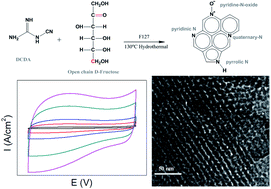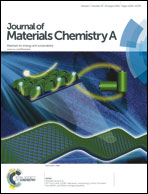Effects of nitrogen doping on supercapacitor performance of a mesoporous carbon electrode produced by a hydrothermal soft-templating process†
Abstract
A soft-templating hydrothermal approach is developed for synthesizing nitrogen (N)-doped mesoporous carbon. D-Fructose and dicyandiamide (DCDA) are used as the starting materials for carbon and nitrogen precursors, respectively, and Pluronic® F127 as the soft template. N-doped mesoporous carbon shows a significant improvement in electrical conductivity and specific capacitance (212 F g−1 under 1 mV s−1 scan rate), compared with the un-doped carbon derived from the same process. A tunable N-doping level (from 4.5 to 14.5 wt%) and specific surface area (ranging from 375 to 730 m2 g−1) are realized by changing the DCDA to D-Fructose weight ratio. The three factors that affect the electrochemical performance, including the specific surface area, electrical conductivity and pseudocapacitance, have been systematically studied. Doping of 6.0 wt% N into carbon appears to be the optimum level for obtaining high electrochemical capacitance. In this work, the effects of N-doping and the interactions among the three factors affecting the capacitance are clarified, shedding light on the future work on the rational design of electrode materials for improved electrochemical performance.


 Please wait while we load your content...
Please wait while we load your content...